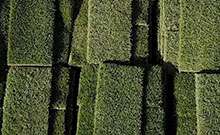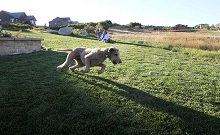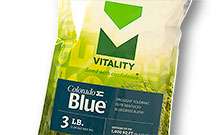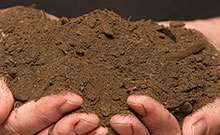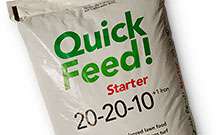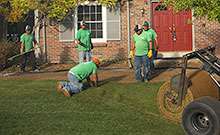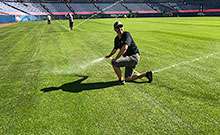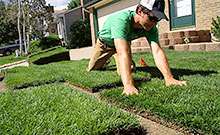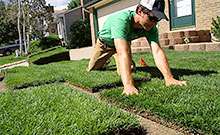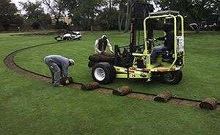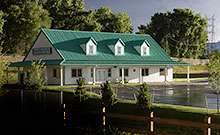Brown Spots in New Sod
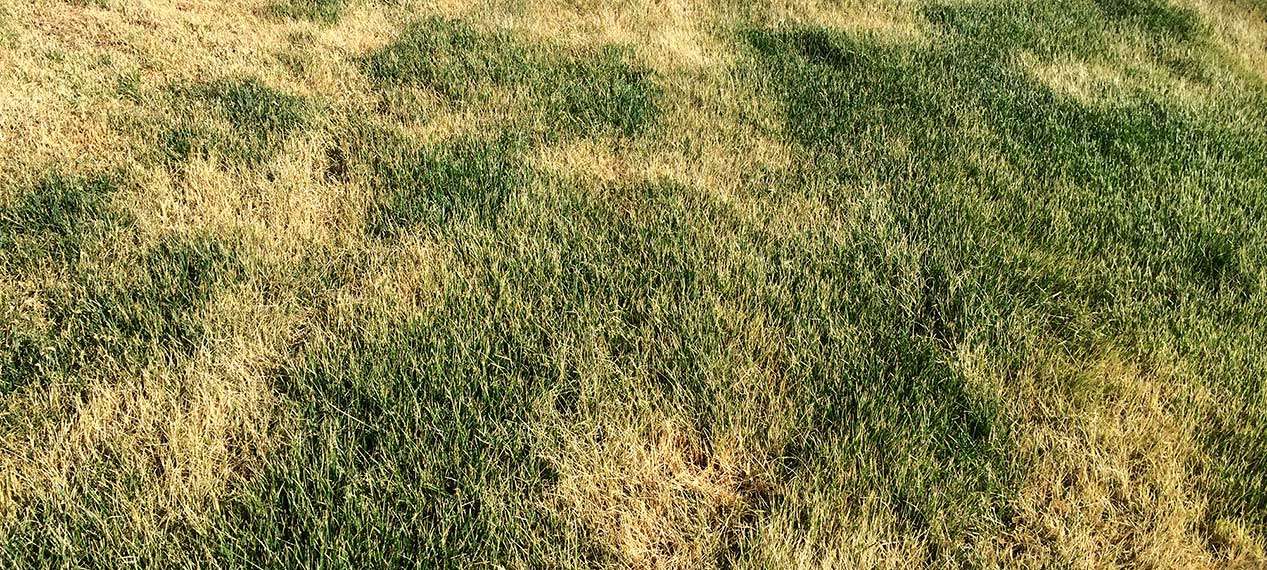
What causes brown spots
As cooler spring days fade into the heat of summer, new lawns are plagued with brown spots. This is an easy fix! Typically, brown spots are caused by a lack of watering. New sod is especially prone to drying out because of its shallow root system. Brown spots occur when sod dries out and experiences drought shock. Sod will go into dormancy to combat the lack of water it’s experiencing. Once dormant, it needs water or it will die. Oftentimes, edges of sod dry out first because they are exposed to the moist air. Spotting in sod occurs for a variety of reasons, but it mostly depends on how water is dispersed around the yard. If the grade of your lawn has dips and valleys, it can cause uneven watering patterns. If certain spots get less water, even a tiny bit less, it could be enough to turn them brown.
Why is new sod more prone to brown spots?
New sod has a very shallow and underdeveloped root system that’s only about ¾ of an inch deep. Wind or hot air can cause the plant to dry out. A lot of times the ground below new sod will be wet but the sod itself is drying out. The root system needs a chance to establish deeper into the ground before it can access that water. Without a more mature root system, new sod relies on you to keep it watered. It takes 6-8 weeks for the sod to establish a strong enough root system to take in water from the ground. In the meantime, it’s up to you to keep it well watered while it grows!
How do I fix brown spots in my lawn?
Now that you know a little more about why brown spots are caused, you’re probably wondering how to fix them. The answer is water. Especially with the hot summer weather. Oftentimes watering every day is not enough for new lawns! If the grass is dry, it needs water. Especially in the first 8 weeks after it’s installed. Watering your lawn for a longer period at night is a great idea. It gives the sod a thorough drink that won’t evaporate right away with the heat of the day. It’s still important to periodically water throughout the day.
Will Fertilizer fix brown spots?
Fertilizer won’t help your grass until it’s green and healthy again. If the sod is dying, the fertilizer won’t take. Wait to fertilize until it has greened back up. Once your sod is healthy, fertilizer helps it grow and establish the deeper root system it needs. So what it comes down to is more frequent irrigation cycles and hand watering the brown spots until that root system becomes established.
Although brown spots in new lawns can be frustrating, it’s sod’s way of asking for a drink. So keep your brand new lawn happy and healthy by making sure it gets plenty of water when brown spots appear!
New Sod Turning Brown - Causes and Solutions
When you've invested time and money into laying new sod, it can be disheartening to see it turning brown. But don't worry; you're not alone, and there are solutions. In this post, we'll explore the common reasons why new sod turns brown and what you can do to fix it.
Common Reasons Why Sod Turns Brown
There are several reasons why your new sod might be turning brown, including:
- Insufficient watering
- Poor soil preparation
- Pests or diseases
- Improper mowing
Each of these factors can contribute to the browning of your sod, and it's important to identify the root cause of the problem before attempting to fix it. Let's dive deeper into each of these causes and explore how you can address them to ensure a lush, green lawn.
1. Check Your Watering Schedule
One of the most common reasons why sod turns brown is insufficient watering. New sod requires a lot of water to establish roots in the soil. Make sure you are watering your sod enough, especially during hot or dry weather. A good rule of thumb is to water the new sod daily for the first few weeks, then gradually reduce the frequency as the sod establishes roots.
When watering your sod, it's important to ensure that the water penetrates the soil to a depth of at least 4 to 6 inches. This encourages deep-root growth and helps the sod establish a strong, healthy foundation. You can use a screwdriver or similar tool to check the moisture level of the soil. If the screwdriver easily penetrates the soil, then it's likely that your sod is receiving enough water. If the soil is hard and dry, you'll need to increase your watering frequency or duration.
2. Improve Soil Preparation
Poor soil preparation can also lead to brown sod. Before laying new sod, it's essential to prepare the soil properly. This includes removing weeds, tilling the soil, and adding necessary nutrients. Learn more about soil preparation for sod new sod is brown. Testing your soil's pH level and nutrient content can also help you identify any deficiencies that need to be addressed.
When preparing the soil for sod, it's important to remove any rocks, roots, or other debris that could interfere with root growth. You should also level the soil to ensure that the sod lays flat and has good contact with the soil. If your soil is compacted, consider aerating it to improve drainage and allow the roots to penetrate the soil more easily. Adding organic matter, such as compost, can also improve soil structure and provide essential nutrients for your sod.
3. Watch Out for Pests and Diseases
Pests and diseases can also cause sod to turn brown. Common pests that affect sod include grubs, sod webworms, and armyworms. Diseases like brown patches, dollar spots, and pythium blight can also cause brown spots on sod. Keep an eye out for signs of infestations or infections and treat them promptly. If you're unsure how to handle pests or diseases, consult with a professional or reach out to your local extension office for advice.
Preventing pests and diseases starts with proper lawn care. A healthy lawn is less likely to be affected by pests and diseases. Make sure you are fertilizing your lawn according to the needs of your grass type, and avoid overwatering, as this can create a conducive environment for pests and diseases. Regularly inspect your lawn for signs of pests and diseases, and treat them promptly to prevent them from spreading.
4. Practice Proper Mowing Techniques
Improper mowing can stress out new sod and cause it to turn brown. Make sure you are mowing at the right height and with sharp blades. Also, avoid mowing when the grass is wet to prevent the spread of diseases. Check out our articleswhy is my sod turning brown and why is my new sod turning brown for options that are easy to maintain.
When mowing your lawn, it's important to follow the "one-third rule," which means you should never remove more than one-third of the grass height at a time. Cutting too much grass at once can stress the sod and cause it to turn brown. Also, make sure your mower blades are sharp, as dull blades can tear the grass and create jagged edges that are more susceptible to disease. Mowing in different directions each time can also help prevent compaction and encourage even growth.
5. Seasonal Lawn Care
Your lawn's needs change with the seasons, and it's important to adjust your lawn care routine accordingly. In the spring, focus on fertilizing and aerating your lawn to promote healthy growth. During the summer, water your lawn regularly and monitor for pests and diseases. In the fall, consider overseeding to fill in any bare spots and improve the overall thickness of your lawn. Winter is a time for rest, but you can still protect your lawn by avoiding walking on it when it's frozen.
6. Common Mistakes to Avoid
When caring for your new sod, it's important to avoid common mistakes that can lead to brown patches. Avoid overwatering, as this can lead to root rot and other problems. Also, avoid under-watering, as this can cause the grass to dry out and turn brown. Be sure to use the right type of fertilizer for your grass type, and avoid fertilizing during hot or dry periods. Lastly, avoid mowing your lawn too short, as this can stress the grass and make it more susceptible to pests and diseases.
7. Choosing the Right Type of Sod
Not all sod is created equal, and the type of sod you choose can have a big impact on its success. When selecting sod, consider your climate, soil type, and the amount of sunlight your lawn receives. Some types of grass are better suited to certain conditions than others. For example, Bermuda grass is a good choice for hot, sunny climates, while fescue grass is better suited to cooler, shadier conditions. Consult with a professional or your local extension office to determine the best type of sod for your lawn.
8. Tips for Maintaining a Healthy Lawn
Maintaining a healthy lawn requires regular care and attention. Here are some tips to help you keep your lawn looking its best:
- Water your lawn deeply and infrequently to encourage deep root growth.
- Fertilize your lawn according to the needs of your grass type.
- Keep your mower blades sharp and mow at the right height for your grass type.
- Aerate your lawn regularly to improve drainage and reduce compaction.
- Monitor for pests and diseases and treat them promptly.
Conclusion
With the right care, your new sod should thrive and provide you with a beautiful, green lawn. Remember to water sufficiently, prepare the soil properly, watch out for pests and diseases, and practice proper mowing techniques. If you follow these steps, you should be able to prevent your sod from turning brown and enjoy a lush, healthy lawn for years to come.
For more information on maintaining a healthy lawn, check out our other resources and articles available on our website.

